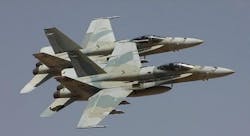Boeing wins $1.5 billion contract to build 22 F/A-18E/F combat aircraft for Kuwait
Officials of the Naval Air Systems Command at Patuxent River Naval Air Station, Md., are asking the Boeing Defense, Space & Security segment in St. Louis to build 22 single-seat F/A-18E jets and six two-seat F/A-18F jets for Kuwait.
The twin-engine carrier-capable multirole fighter and light-attack F/A-18E/F combat jets are based on the McDonnell Douglas F/A-18 Hornet, which entered U.S. Navy squadrons in 1983, but are larger and more advanced derivatives. The F/A-18E/F has a larger wing and a longer fuselage to carry more fuel and more powerful engines.
The newest versions of the F/A-18 first flew in 1995, and entered Navy service in 1999. These aircraft replaced variants of the Navy's F-14 Tomcat jet fighters, A-6 Intruder medium-attack bombers, and S-3 Viking carrier-based maritime patrol jet.
The Super Hornet has an internal 20-millimeter M61 rotary cannon and can carry air-to-air missiles and air-to-surface weapons. The planes can carry additional fuel in as many as five external fuel tanks. These jets also can function as airborne tankers with external air refueling systems.
Related: Harris advanced targeting systems enable Navy jets to find and attack targets quickly
The Super Hornet aircraft have improved active electronically scanned array (AESA) radar, large displays, the joint helmet mounted cuing system, and several other avionics replacements.
The Super Hornet has a modern mission computer, and infrared search and track (IRST) electro-optical passive surveillance and targeting system.
The F/A-18E/F avionics suite features an up-front touchscreen control display; a large multipurpose color liquid-crystal display; and a fuel display. It has a quadruplex digital fly-by-wire system, and digital flight-control system that detects and corrects for battle damage.
The aircraft has the Raytheon AN/APG-79 AESA radar for search, track, and attack, as well as the Raytheon AN/ASQ-228 Advanced Targeting Forward Looking Infrared (ATFLIR) electro-optical sensor and laser designator pod.
Related: Navy asks BAE Systems to build F/A-18 aircraft antennas that cut through enemy GPS jamming
The Super Hornet's communications equipment includes AN/ARC-210 VHF/UHF radio and a MIDS-JTRS low volume terminal for HAVE QUICK, SINCGARS, and Link 16 RF communications and tactical networking. Its defensive avionics have the AN/ALR-67(V)3 radar warning receiver, the AN/ALE-47 countermeasures dispenser, the AN/ALE-55 towed decoy, and the AN/ALQ-214 integrated defensive countermeasures (IDECM) system with internally mounted threat receivers and optional self-protection jammers.
The Super Hornet's Shared Reconnaissance Pod (SHARP) is a high-resolution, digital tactical aerial reconnaissance system with advanced day, nighttime, and all-weather capability.
On this order Boeing will do the work in El Segundo, Torrance, Santa Ana, and Santa Clarita, Calif.; Hazelwood, Mo.; Bloomington, Minn.; Clearwater and Fort Walton Beach, Fla.; Clifton, N.J.; Ontario, Canada; Kalamazoo, Mich.; Fort Worth, Texas; Mesa, Ariz.; Vandalia, Ohio; Endicott, East Aurora, and Greenlawn, N.Y., and other U.S. locations, and should be finished by January 2021.
For more information contact Boeing Defense, Space & Security online at www.boeing.com/company/about-bds, or Naval Air Systems Command at www.navair.navy.mil.
Ready to make a purchase? Search the Intelligent Aerospace Buyer's Guide for companies, new products, press releases, and videos
